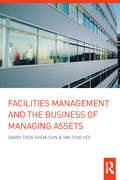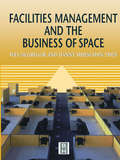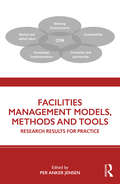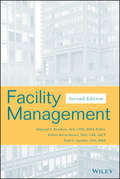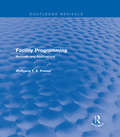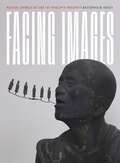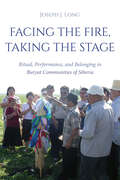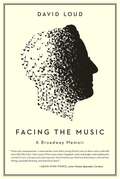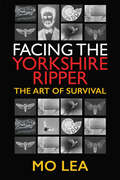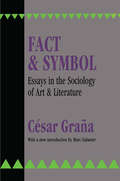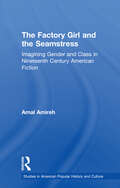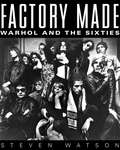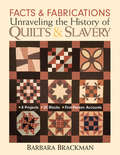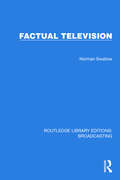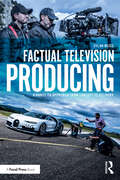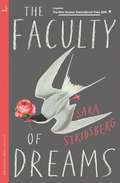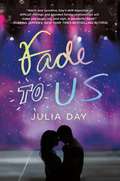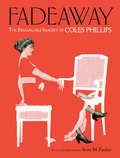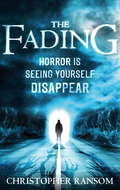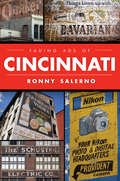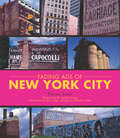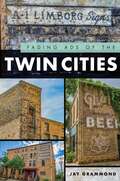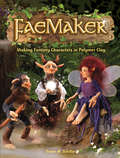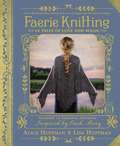- Table View
- List View
Facilities Management and the Business of Managing Assets
by Danny Then Shiem-Shin Tan Teng HeeThe importance of facilities management to the effective operation of all businesses is now widely accepted. Where there continues to be debate is on what constitutes a successful approach, and how much attention it should be given within an overall business plan. Drawing on both research and current practice, this book provides a systematic, innovative, and business-focused approach to the management of facilities assets. The reader will discover why and how to use facility assets to achieve business goals and strategies by aligning them as a resource. Striking a balance between management and technical aspects, the book covers: the basics of facilities asset management and the key elements of a systematic management approach the key supporting capabilities for facilities management as a business function a framework for considering strategic alignment of facilities assets and associated services with business needs the role of life-cycle asset management and its contribution to business resource management. The message of this book and the benefits it can bring to businesses everywhere make it essential reading for executives as well as facilities managers. Its detailed explanations of all of the key concepts involved, and lists of recommended further reading also make it an excellent resource for those new to the industry, and for students of property or facilities management.
Facilities Management and the Business of Space
by Wes McGregorEssential reading for building owners, facilities managers, architects and surveyors, this book will also prove useful on business management and facilities management courses, and for those studying architecture, surveying and real estate management.
Facilities Management Models, Methods and Tools: Research Results for Practice
by Per JensenThis book presents research tested models, methods and tools that can make the work of the facilities manager more robust and sustainable, help long-term strategic planning and support students and practitioners in FM to improve the way they approach and deal with challenges in practice. The 34 models, methods and tools are presented in relation to five typical challenges for facilities managers: Strategy development Organisational design Space planning Building projects Optimisation The chapters are short and concise, presenting a central illustration of one model, method or tool with explanatory text and short, exemplary case studies. Each chapter includes references to further reading, and the book includes a keyword index. Essential reading for all involved in the management of built assets, this book bridges the gap between robust academic research and practical industry tools. It can also be used as a handy student reference.
Facility Management
by Edmond P. Rondeau Paul D. Lapides Robert Kevin BrownFrom the moment it was first published, Facility Management became the ultimate reference for facility and design professionals who want to create a productive workplace that corresponds to the short- and long-term goals of their corporation. This Second Edition provides complete, fully up-to-date information and guidance on the evolving facility management profession that will help facility professionals and their service providers meet and exceed these goals.
Facility Programming: Methods and Applications (Routledge Revivals)
by Wolfgang F. PreiserFirst published in 1978, the objective of this book is to provide an authoritative and selective overview of current, user-orientated programming methods within the field of environmental design. The 19 chapters compiled in this volume describe procedures and the information content of innovative approaches used by leading programming experts in the private and institutional sectors. Emphasis is placed on a qualitative and illustrative focus of selected approaches to environmental programming with the eventual occupants in mind. The chapter groupings are intended to reflect three major areas of professional engagement that serve the field of facility programming. The first group describe the approaches of firms or groups that were organised exclusively to provide environmental analysis and programming services. Part II is composed of chapters by authors who belong to established architectural firms with programming departments and Part III presents evidence that pertains to the supporting role of research and guidance literature from authors primarily affiliated with government agencies or supported by large organisations.
Facing Images: Medieval Japanese Art and the Problem of Modernity (Refiguring Modernism)
by Kristopher W. KerseyIf we want to decolonize the history of art, argues Kristopher Kersey, we must rethink our approach to the historical record. This means dispensing with Eurocentric binaries—divisions between Western and non-Western, modern and premodern—and making a commitment to artworks that challenge the perspectives we build upon them. In Facing Images, the question takes elegant and intriguing form: If the aesthetic hallmarks of “modernity” can be found in twelfth-century art, what does it really mean to be “modern”?Kersey’s answer to this question models a new historiography. Facing Images begins by tracing the turbulent discourse surrounding the emergence of Japanese art history as a modern field. In lieu of examining canonical works from the twelfth century, Kersey foregrounds the elusive and the enigmatic in artworks little known and understudied outside Japan; the manuscripts he selects defy traditional art-historical narratives by exhibiting decidedly modern techniques, including montage, self-reference, reuse, noise, dissonance, and chronological disarray. Kersey weaves these medieval case studies together with insights from a wide range of interdisciplinary scholarship, using a methodology that will prove important for historians: Facing Images produces a history of non-Western art in which diverse and anachronic works are brought responsibly and equitably into dialogue with the present, without being subsumed under Eurocentric formalisms or false universals.A timely intervention in the history of medieval Japanese art, art historiography, and the history of global modernism, Facing Images redefines the relationship of the “premodern” non-West to “modern” art. It will be of particular interest to scholars of medieval Japanese art and of modernism.
Facing the Fire, Taking the Stage: Ritual, Performance, and Belonging in Buryat Communities of Siberia
by Joseph J. LongIn the mid-2000s, the Russian government began to merge Siberia's smallest Indigenous territories into larger administrative regions. Among Buryat Mongols living to the west of Lake Baikal the state promoted a policy of "National Cultural Autonomy," which sought to separate culture from territory amid this consolidation of land and people. Although public performances of Buryat culture were mobilized to show support for the policy, Joseph Long's compelling ethnography provides alternative ways to understand the meanings attached to these displays. At the same time, the book documents how resurgent local rituals demonstrated enduring ties to the land. Drawing on classic theories of ritual and performance, Facing the Fire, Taking the Stage explores how Buryat shamanism and state-sanctioned performing arts have allowed Buryats to negotiate and express different kinds of belonging to people and land. Based on several years of anthropological fieldwork in Western Buryat communities, this book provides new insights into the ways that these forms have influenced one another over time.While Buryat experience has been fundamentally shaped by Soviet communism and its aftermath, Facing the Fire, Taking the Stage shows how this history parallels the experience of Indigenous peoples worldwide.
Facing the Music: a Broadway memoir
by David LoudMusical Director and arranger David Loud, a legendary Broadway talent, recounts his wildly entertaining and deeply poignant trek through the wilderness of his childhood and the edge-of-your-seat drama of a career on, in, under, and around Broadway for decades. He reveals his struggle against the ravages of Parkinson's and triumphs repeatedly. This memoir is also a remarkable love letter to music. Loud is the 'Ted Lasso' of the theater business, ever the optimist!&“&‘Music has consequences,&’ a wise teacher once told a young David Loud; so does a story well-told and a life fully-lived. I lost count of how many times I laughed, cried, and laugh-cried reading this wonderful, wry, intimate, and inspiring book. David wields a pen like he wields a baton, with perfect timing, exquisite phrasing, and enormous heart.&” — David Hyde Pierce, actor, Frasier, Spamalot, Curtains &“Beautifully written, filled with vivid details, braided with love and loss and wit and the perspective of someone with an utterly unique story to tell." -- Lynn Ahrens, lyricist, Ragtime, Once on This Island, Anastasia &“Luminous and surprising, an extremely honest memoir of a life lived in the world of Broadway musicals, by one of the theatre&’s most gifted conductors. I can&’t think of another book quite like it.&” -- John Kander, composer, Cabaret, Chicago, New York, New York Unforgettably entertaining and emotionally revealing, Loud is pitch-perfect as he describes his path to the podium, from a stage-struck kid growing up at a school devoted to organic farming and mountain climbing, to the searing formative challenges he faces during adolescence, to the remarkable behind-the-scenes stories of his Broadway trials and triumphs. Skilled at masking his fears, Loud achieves his dream until one fateful opening night, when in the midst of a merry, dressing room celebration, he can no longer deny reality and must suddenly, truly, face the music.
Facing the Yorkshire Ripper: The Art of Survival
by Mo LeaDecades after her brutal attack by the notorious serial killer, an artist tells her story of survival and recovery in this uplifting memoir.Mo Lea was a young art student in Leeds when her life was changed forever by a deadly assault. On October 25th, 1980, serial killer Peter Sutcliffe attacked her with a hammer and stabbed her with a screwdriver. Surviving with a fractured skull and PTSD, Mo spent years wrestling with a morbid narrative that cast her as a victim. Now Mo offers a fresh perspective on her life, sharing valuable insight into her successful recovery process. While art had always been important to her, it became a vital outlet for exploring her pain, her anger, and her ultimate triumph over them. Drawing a meticulous portrait of Sutcliffe, she then found catharsis in tearing it to bits—ripping up the Ripper.In candid words and stirring illustrations, Mo reclaims her own story, telling of her journey from tragic despair to calmness and acceptance.
Fact and Symbol: Essays in the Sociology of Art and Literature
by César Graña Marc GalanterCesar Grafla's work critically examines the continual rebirth of cultural romances on the part of literaiy Intellectuals. Grafia's disdain for contrived rejections of modernity and for grand destructive gestures is combined with his intense appreciation of the romantic sensibility. Fact and Symbol embodies Grafta’s views of the enterprise of cultural sociology in which both words are given equal play. This book consists of seven essays. Five shorter pieces on the relation of art to American democracy are bracketed by two long essays, the first on the literaiy critique of modern life, the last on Spanish American cultural nationalism. Among the temes covered throughout the book are attitudes prevalent during the post-romantic era, the French impressionists, art museums, the transformation of the industrial and commercial elite of America, and Spanish-American literary Utopians. In a new Introduction, written especially for this edition, Marc Galanter outlines Graiia’s ideas and explains what he was aiming to do when he originally wrote these essays. Fact and Symbol presents Graiia’s unique viewpoint and will be enjoyed by scholars of art and literature, as well as sociologists. One can well appreciate why this book was nominated for a National Book Award on its original release. It is a pioneering achievement in the sociology of culture.
The Factory Girl and the Seamstress: Imagining Gender and Class in Nineteenth Century American Fiction (Studies in American Popular History and Culture)
by Amal AmirehThis book studies the representations of working-class women in canonical and popular American fiction between 1820 and 1870. These representations have been invisible in nineteenth century American literary and cultural studies due to the general view that antebellum writers did not engage with their society's economic and social relaities. Against this view and to highlight the cultural importance of working-class women, this study argues that, in responding to industrialization, middle class writers such as Melville, Hawthorne, Fern, Davies, and Phelps used the figures of the factory worker and the seamstress to express their anxieties about unstable gender and class identitites. These fictional representations were influenced by, and contributed to, an important but understudied cultural debate about wage labor, working women, and class.
Factory Made
by Steven WatsonFactory Made: Warhol and the Sixties is a fascinating look at the avant-garde group that came together--from 1964 to 1968--as Andy Warhol's Silver Factory, a cast that included Lou Reed, Nico, Edie Sedgwick, Gerard Malanga, Paul Morrissey, Joe Dallesandro, Billy Name, Candy Darling, Baby Jane Holzer, Brigid Berlin, Ultra Violet, and Viva. Steven Watson follows their diverse lives from childhood through their Factory years. He shows how this ever-changing mix of artists and poets, musicians and filmmakers, drag queens, society figures, and fashion models, all interacted at the Factory to create more than 500 films, the Velvet Underground, paintings and sculpture, and thousands of photographs. Between 1961 and 1964 Warhol produced his most iconic art: the Flower paintings, the Marilyns, the Campbell's Soup Can paintings, and the Brillo Boxes. But it was his films--Sleep, Kiss, Empire, The Chelsea Girls, and Vinyl--that constituted his most prolific output in the mid-1960s, and with this book Watson points up the important and little-known interaction of the Factory with the New York avant-garde film world. Watson sets his story in the context of the revolutionary milieu of 1960s New York: the opening of Paul Young's Paraphernalia, Truman Capote's Black and White Ball, Max's Kansas City, and the Beautiful People Party at the Factory, among many other events. Interspersed throughout are Watson's trademark sociogram, many black-and-white photographs--some never before seen--and quotes and slang that help define the Warholian world. With Factory Made, Watson has focused on a moment that transformed the art and style of a generation.With a new Introduction to the eBook Edition and outtakes from Steven Watson's Silver Factory interviews, 1999-2002. Note: The eBook edition includes 60 select photographs from the print edition.
Facts and Fancies: Essays Written Mostly for Fun
by Paul TaylorWitty and whimsical writings about the dance of life by the legendary choreographer. This wonderful new book by one of the preeminent dancers and choreographers consists of a range of pieces of fact and fiction that run from thoughts on friendliness and country living to animosity and city life. Taylor&’s first book since his autobiography (Private Domain, 1995, Alfred A. Knopf) is a romp through his playful mind, with chapter titles such as: Why I Make Dances, The Redheaded Spiritualist, Martha Close Up, Clytemnestra, How to Tell Ballet from Modern, and In the Marcel Proust Suite of L&’Hotel Continental. &“No other dancer ever looked like Paul Taylor, that strapping, elastic, goofy hunk of a guy, and no one else&’s dance works look like his either—not the deep, dark ones or the zany ones or the uplifting ones. His vocabulary, his tone are unique and unmistakable. The same thing is true, it turns out, about his writing. His style is utterly his own, and like all real style it isn&’t a calculated voice but a reflection of the way his quirky mind works.&” —From the foreword by Robert Gottlieb &“Taylor has not cultivated one writing persona, but has unleashed a raft of voices in a raft of forms: travesty, comedy, fiction, essay, satire, allegory, poetry, fable, epistle. While many of these selections are humorous, as anyone familiar with Taylor&’s choreography knows, even in the sunniest of his dances, there are often threatening clouds on the horizon. And the canny Taylor recognizes when to swap his Janus masks for maximum emotional wallop.&” —From the introduction by Suzanne Carbonneau
Facts & Fabrications: From Practice To Perfection -- Troubleshooting Guide -- 50+ Designs
by Barbara Brackman“A renowned quilt historian . . . present[s] what she considers to be an accurate assessment of slavery, quilts and the Underground Railroad.” —TimeRecall an unforgettable phase of our nation’s history with America’s leading quilt historian. Barbara Brackman presents the most current research on the role of quilts during the time of slavery, emancipation, and the Underground Railroad. Nine quilt projects combine historic blocks with Barbara’s own designs.Did quilts really lead the way to freedom? What role did quilts play? Barbara explores the stories surrounding the Underground Railroad.Read about the people who were there! First-person accounts, newspaper and military records, and surviving quilts all add clues. YOU decide how to interpret the stories and history, fabrication and facts as you learn about this fascinating time in history. Excellent resource for elementary through high school learners—curriculum included! “Quilters interested in African American slavery and quilting will find many historically accurate, teachable moments within these pages. The first-personal accounts by slaves of their quilt making, quilt parties, and stolen quilts make emotional reading. A must-have book for your quilting library!” —Kyra Hicks, author of Black Threads“Brackman skillfully assembles accurate historical evidence along with beautiful quilt examples infused with slave-era symbolism.” —Dr. Carolyn Mazloomi, author of Threads of Faith“Many of persons featured or quoted are women with a connection to the ‘peculiar institution’: slaves, escaped slaves, freed slaves, plantation owners, abolitionists, and so forth . . . teaches history through quilting and offers fun projects for history-minded quilters . . . the stories offer good starting points for one’s own research and the projects are beautiful.” —Beth’s Bobbins
Factual Television (Routledge Library Editions: Broadcasting #20)
by Norman SwallowFactual Television (1966) looks at the techniques and purpose of all facets of factual television – news and current affairs programmes; documentaries; reporting stories; the ethics of reporters and producers. It quotes at length from television writers, producers and television executives, to give very much an insider’s view of the arena.
Factual Television Producing: A Hands On Approach From Concept to Delivery
by Dylan WeissThis book is an unvarnished look at how to originate, pitch, sell, and produce factual television programming for global broadcast television networks and streaming services. Grounded in firsthand experience, this essential "how to guide" walks readers through the crucial steps in the factual television process while unpacking valuable insights to successfully producing and delivering projects on time and on budget. With over 20 years of experience in the TV documentary arena, Executive Producer Dylan Weiss shares how to break into the industry, originate your own documentary ideas, forge a path forward through the creative process, prepare your concepts for commissioners, and then pitch them to networks, broadcasters, streamers, and distributors around the world. Industry voices are layered throughout sharing their experiences from each stage of the process. These interviews include top executives from Disney, Investigation Discovery, National Geographic, and many more. This is an ideal resource for independent documentary producers looking to create and pitch their work to top television networks and streaming services.
The Faculty of Dreams: Longlisted for the Man Booker International Prize 2019
by Sara StridsbergIn April 1988, Valerie Solanas - the writer, radical feminist and would-be assassin of Andy Warhol - was discovered dead in her hotel room, in a grimy corner of San Francisco. She was only 52; alone, penniless and surrounded by the typed pages of her last writings.In The Faculty of Dreams, Sara Stridsberg revisits the hotel room where Solanas died, the courtroom where she was tried and convicted of attempting to murder Andy Warhol, the Georgia wastelands where she spent her childhood, where she was repeatedly raped by her father and beaten by her alcoholic grandfather, and the mental hospitals where she was interned.Through imagined conversations and monologues, reminisces and rantings, Stridsberg reconstructs this most intriguing and enigmatic of women, articulating the thoughts and fears that she struggled to express in life and giving a powerful, heartbreaking voice to the writer of the infamous SCUM Manifesto.
Fade to Us
by Julia DayJulia Day's Fade to Us is a story about found families, the bond of sisterhood, and the agony and awe of first love.Brooke's summer is going to be EPIC— having fun with her friends and a job that lets her buy a car. Then her new stepfather announces his daughter is moving in. Brooke has always longed for a sibling, so she’s excited about spending more time with her stepsister. But she worries, too. Natalie has Asperger’s--and Brooke's not sure how to be the big sister that Natalie needs.After Natalie joins a musical theater program, Brooke sacrifices her job to volunteer for the backstage crew. She’s mostly there for Natalie, but Brooke soon discovers how much she enjoys being part of the show. Especially sweet is the chance to work closely with charming and fascinating Micah--the production’s stage manager. If only he wasn't Natalie's mentor...When her summer comes to an end, will Brooke finally have the family she so desperately wants--and the love she's only dreamed about?
Fadeaway: The Remarkable Imagery of Coles Phillips (Dover Fine Art, History of Art)
by Jeff A. Menges Coles Phillips Mr Scott FischerColes Phillips (1880–1927) was among the most in-demand illustrators in his field during the 1910s and 20s. A dynamic and highly skilled watercolor artist and draftsman, Phillips created dozens of covers for mainstream American magazines, including Good Housekeeping, Life, and The Saturday Evening Post. In 1908 he created a style in which the figure in the foreground blended seamlessly into the background, rendering some amount of the clothing invisible save for the edges. Dubbed "The Fadeaway," the eye-catching technique became a huge hit and was employed to great effect by the artist for most of his career.This original compilation features more than 80 color plates selected from two of Phillips' early collections, A Gallery of Girls and A Young Man's Fancy, in addition to images from other sources. An Introduction by illustrator and graphic designer Scott M. Fischer provides a modern appraisal and speaks to Phillips' lasting influence. Students of illustration, graphic design, and advertising as well as fans of 1920s fashion will appreciate this collection of striking works by a Golden Age designer-illustrator.
The Fading
by Christopher RansomWHAT WOULD YOU DO IF YOU COULD BECOME INVISIBLE?A GIFTSince childhood, Noel Shaker has been able to disappear, without warning or explanation.A CURSEBut his gift leaves Noel alone and afraid - and the more he tries to control it, the nearer he comes to madness.A DISCOVERYWhen Noel learns that some people can see him - and that his power has unleashed an otherworldly evil - he must discover the source of his 'fading'. But the truth is dark and dangerous - an unpredictable, shocking twist unlike any you have ever read.You are holding in your hands the scariest novel of the year. From the internationally bestselling author of The People Next Door comes a story worthy of Stephen King - a story of terror like you've never seen.
Fading Ads of Cincinnati
by Ronny SalernoHidden down alleyways, on street corners or on the bricks above the cityscape, Cincinnati's fading advertisements hide in plain sight. These ghost signs still tout their wares and services, remnants of a bygone era. Each sign has a vivid story behind it unique to its era, product and craftsmanship. "Wall dogs" like sign artist Gus Holthaus left their marks on the city. A sign for the Beehive, the club and restaurant at the top of the arena, reminds residents of Cincinnati's pro hockey team, the Stingers. Not many can remember "the Other Place," but a hand-painted advertisement still adorns a city wall. Join author and photographer Ronny Salerno for a tour of Cincinnati's vanishing signs and their intriguing history.
Fading Ads of New York City (Fading Ads)
by Wm. Stage Frank Jump Dr Andrew Irving Kathleen HulserNew York City is eternally evolving. From its iconic skyline to its side alleys, the new is perpetually being built on the debris of the past. But a movement to preserve the city's vanishing landscapes has emerged. For nearly twenty years, Frank Jump has been documenting the fading ads that are visible, but less often seen, all over New York. Disappearing from the sides of buildings or hidden by new construction, these signs are remnants of lost eras of New York's life. They weave together the city's unique history, culture, environment and society and tell the stories of the businesses, places and people whose lives transpired among them -- the story of New York itself. This photo-documentary is also a study of time and space, of mortality and living, as Jump's campaign to capture the ads mirrors his own struggle with HIV. Experience the ads -- shot with vintage Kodachrome film -- and the meaning they carry through acclaimed photographer and urban documentarian Frank Jump's lens.
Fading Ads of the Twin Cities (Fading Ads)
by Jay GrammondOn brick buildings throughout Minneapolis and St. Paul, overlooked, fleeting symbols chronicle the cities' past.Champion, John Deere, and International Harvester still tout their agricultural equipment, and Gold Medal and Pillsbury Flour remind everyone where these now global companies began. Weathered proclamations from Grain Belt, Jacob Schmidt, and Gluek's Beer offer a glimpse into early local brewing. Ads from Schmitt Music and Dahl Violin Shop recall a thriving art scene. Local hardware stores like Welna Ace Hardware and grocery stores like J.H. Allen & Co Grocers and Schoen's Home Grocery hawk long-gone wares through elegant painted announcements.Join photographer and author Jay Grammond for a fascinating journey through Twin Cities history.
FaeMaker: Making Fantasy Characters in Polymer Clay
by Dawn M. Schiller"For as long as I can remember, I've been drawn to fairy tales and fantasy...and the only thing better than reading about fairies is making them!" Here's your guide to sculpting fantasy characters that are a little quirky, occasionally cranky and definitely fun. Dawn Schiller's "oddfae" are gnarly little folk who are often mischievous and always fun to sculpt. In this book, you'll learn Dawn's secrets for shaping incredibly detailed and friendly (for the most part) little faces, hands and feet, poseable bodies, and true-to-life costumes. Learn about tools, special precautions and quick, simple techniques for working with polymer clay. Follow along to create 9 characters step by step - Chrainn the elf, Ithe the ogre, Zylphia the witch and other fairy tale fugitives. Pick up useful and fun fae facts (such as Fetch the troll's great weakness for sesame seeds). Crank up your imagination, grab your sculpting tools and some clay, and find out who's waiting for you inside. Once you get the hang of it, you'll be ready to bring to life original fae friends of your very own!
Faerie Knitting: 14 Tales of Love and Magic
by Alice Hoffman Lisa HoffmanFrom New York Times bestselling author Alice Hoffman and master knitter Lisa Hoffman comes Faerie Knitting, a magical melding of words and yarn where the ordinary is turned into the extraordinary and where imagination becomes creation.The magic of storytelling and the magic of knitting—woven together in 14 original patterns inspired by each story. &“How fairy tales are told and remembered has a great deal in common with knitting traditions. It is no mistake that we describe storytelling as knitting a tale, or weaving a story, or spinning a yarn.&”—Alice Hoffman, from the Introduction of Faerie Knitting Featuring fourteen original fairy tales, Faerie Knitting is an entrancing collection of stories of love and loss, trust and perseverance. Seamlessly woven into the plot of each tale is a magical garment or accessory inspired by the bravery and self-reliance of the tale&’s heroine and brought to life through an imaginative and bespoke knit pattern. From the Blue Heron Shawl and the Love Never Ending Cowl, to the Three Wishes Mittens and Amulet Necklace, each project is as wearable as it is magical. Lush, atmospheric photography captures the enchanted faerie domain while beautifully rendered charts and instructions are well suited for beginner and advanced knitters alike. Presented in an elegant linen case with foil accents that evoke the fairy tale tradition, Faerie Knitting is a rare gift for creators—and lovers—of magic.
